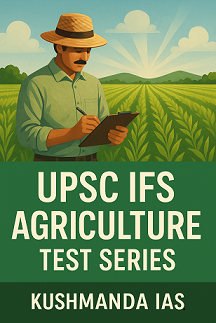UPSC IFS Agriculture Subject Test Series for 2025
UPSC IFS Agriculture Subject Test Series for 2025
The UPSC IFS exam rewards clarity, application, and technical depth. Simply stating facts is not enough; answers must reflect awareness of field applications, recent innovations, and scientific logic. Candidates should also link answers with sustainable development goals (SDGs), policies, or climate resilience when appropriate.
A high-scoring answer in the Agriculture optional includes the following components:
-
Conceptual clarity
-
Use of technical terms and definitions
-
Structured format (Intro-Body-Conclusion)
-
Integration of current developments/research
-
Diagrams/charts/tables where relevant
-
Interdisciplinary and applied approach (e.g., climate-smart agriculture)
-
Conciseness and adherence to word limit
Salient Features:
- 10 Full Length tests. (English&Hindi)
- Evaluators assess on parameters like relevance, structure, depth of analysis, subheading use, keyword usage, multidimensionality, innovation (diagrams, flowcharts), conclusion quality, and time-bound completeness.
- UPSC answers are not essays; they must reflect a balanced viewpoint within word/time limits. Evaluation frameworks ensure candidates develop exam-centric writing that satisfies UPSC’s demand for clarity, content, and conciseness.
- UPSC checks quality under pressure. Evaluation creates a feedback loop where every mistake becomes a lesson. The constant loop of Write → Get Feedback → Rectify → Write Again improves articulation, speed, and scoring capability.
- Focus on key metrics to ensure 300+ Marks .
- High-quality Question as per the latest pattern of UPSC.
- Robust feedback mechanism through copy evaluation in a time bound manner.
- Model Answers of all tests
- Flexible schedule, write anytime after scheduled date.
- Fee: Rs 11000/- (Per Test Rs 1100/-)
Call: 860770992 (Discounts for EconomicallyWeaker Sections for all categories)
EXAMPLE:
Q: Design a holistic agri-ecosystem model for Bundelkhand integrating water harvesting, agroforestry, livestock, renewable energy, and women-led cooperatives. Evaluate its economic and ecological viability.
Holistic Agri-Ecosystem Model for Bundelkhand
Introduction:
Bundelkhand, spanning parts of Uttar Pradesh and Madhya Pradesh, faces recurring droughts, poor soil health, fragmented landholdings, and rural distress. A holistic agri-ecosystem model integrating water harvesting, agroforestry, livestock, renewable energy, and women-led cooperatives offers a transformative solution that is both ecologically regenerative and economically viable.
Model Design Components
1. Water Harvesting & Management:
Due to erratic rainfall, water harvesting is central. The model integrates:
-
Check dams, farm ponds, and percolation tanks at village cluster levels.
-
Rooftop rainwater harvesting in rural homes and schools.
-
Revival of traditional water bodies like johads and baoris for community use.
2. Agroforestry Integration:
Bundelkhand’s degraded land offers scope for agroforestry:
-
Multi-tier cropping systems: Incorporating trees like ber (Ziziphus), moringa, neem, and custard apple with crops like pulses, millets, and oilseeds.
-
Silvipasture systems: Combining fodder trees with grasslands to support livestock.
This improves soil carbon, checks erosion, and diversifies income.
3. Livestock Diversification:
Livestock, already a rural backbone, is strengthened through:
-
Breed improvement (e.g., Sahiwal, Bundelkhandi goats).
-
Integrated dairy and goat rearing units.
-
Dung-based biogas units reducing dependency on firewood and LPG.
4. Renewable Energy Integration:
To offset energy poverty and enhance productivity:
-
Solar pumps for irrigation.
-
Community solar microgrids for cold storage, food processing units.
-
Biogas for household cooking and decentralized power.
5. Women-led Cooperatives:
Women play a pivotal role in this ecosystem:
-
Formation of SHG-based agro-enterprises for seed banks, organic composting, dairy, and food processing (e.g., achar, millet-based snacks).
-
Training in agri-tech, bookkeeping, and digital payments.
-
Market linkages through FPOs (Farmer Producer Organizations) and e-NAM platforms.
Economic Viability
-
Diversified Income Streams: Agroforestry reduces seasonal dependency; livestock, biogas, and food processing add year-round income.
-
Reduced Input Costs: Organic composting, biogas slurry, and solar energy lower expenses on fertilizers, LPG, and diesel.
-
Job Creation: Women-led cooperatives create rural employment, reduce male migration.
-
Export and Value Addition Potential: Millet-based products, herbal medicines, and honey have high market demand.
Case Study Reference: Similar integrated models in Maharashtra (e.g., Pani Foundation villages) showed 250–300% increase in household income over 3–5 years.
Ecological Viability
-
Water Security: Rainwater harvesting increases groundwater recharge, reduces dependency on erratic monsoons.
-
Soil Regeneration: Leaf litter, organic inputs, and tree root systems enhance soil fertility and biodiversity.
-
Climate Resilience: Mixed farming and tree cover buffer against droughts and floods.
-
Carbon Sequestration: Agroforestry and silvipasture act as carbon sinks, contributing to climate mitigation goals.
Conclusion
The proposed Bundelkhand agri-ecosystem model integrates traditional wisdom with modern sustainability practices. It addresses water scarcity, income insecurity, gender inequality, and ecological degradation simultaneously. With appropriate policy support, local participation, and capacity building, this model can serve as a replicable blueprint for climate-resilient rural transformation in semi-arid India.
Evaluation Framework:
1. Structure and Organization: (9/10)
-
Strengths:
The answer is well-structured with clear headings—Introduction, Model Design Components, Economic Viability, Ecological Viability, and Conclusion. Logical flow from problem identification to solution and evaluation. -
Improvement:
Could briefly mention stakeholder roles (govt, NGOs, panchayats) under implementation.
2. Content Relevance & Coverage: (10/10)
-
Strengths:
Each of the five demanded elements—water harvesting, agroforestry, livestock, renewable energy, and women-led cooperatives—is clearly addressed with practical solutions suited to Bundelkhand’s semi-arid ecology. -
Highlights:
-
Locally adapted agroforestry (ber, moringa).
-
Integration of SHGs and FPOs for women.
-
Use of solar microgrids, biogas.
-
Mention of silvipasture and revival of johads reflects regional grounding.
-
-
Improvement:
Brief mention of land rights or community participation mechanisms would enhance completeness.
3. Economic Viability Analysis: (8.5/10)
-
Strengths:
Identifies multiple income streams, cost reductions, and value-addition potential. The mention of millets, medicinal plants, and market linkages reflects practical strategies. -
Case study inclusion (Pani Foundation) adds credibility.
-
Improvement:
-
Could include quantified yield improvements, ROIs, or per-acre income shifts for precision.
-
Slightly more on access to credit or subsidies (e.g., PM-KUSUM, NABARD schemes) would be ideal.
-
4. Ecological Viability Analysis: (9/10)
-
Strengths:
Strong grasp of soil health, water security, climate resilience, and biodiversity. Points on carbon sequestration and drought-buffering are well-articulated. -
Improvement:
-
More specific biodiversity outcomes or watershed-level impact (e.g., recharge rates or erosion reduction) would deepen analysis.
-
5. Language, Clarity & Precision: (9/10)
-
Strengths:
Crisp, academic tone; uses technical yet accessible language (e.g., silvipasture, agro-enterprises). -
Improvement:
Could vary sentence structures slightly more and avoid repetition of phrases like “women-led cooperatives”.
6. Innovation and Originality: (9/10)
-
Strengths:
The multi-layered integration of traditional and modern techniques (e.g., biogas + solar + agroforestry) and the women-led enterprise aspect is a notable innovation. -
Improvement:
A visual model or schematic (in real-world use) would enhance impact.
Final Evaluation:
| Criterion | Score (Out of 10) |
|---|---|
| Structure & Organization | 9 |
| Content Coverage | 10 |
| Economic Viability | 8.5 |
| Ecological Viability | 9 |
| Language & Clarity | 9 |
| Innovation & Originality | 9 |
| Total | 54.5/60 |
| Scaled Score (/100) | 90.8% |
Verdict:
This is a high-quality answer (90%+) that effectively balances technical, economic, and ecological insights. It demonstrates grounded realism, regional customization, and gender-inclusive sustainability—qualities essential for UPSC Mains or interview scenarios.
















